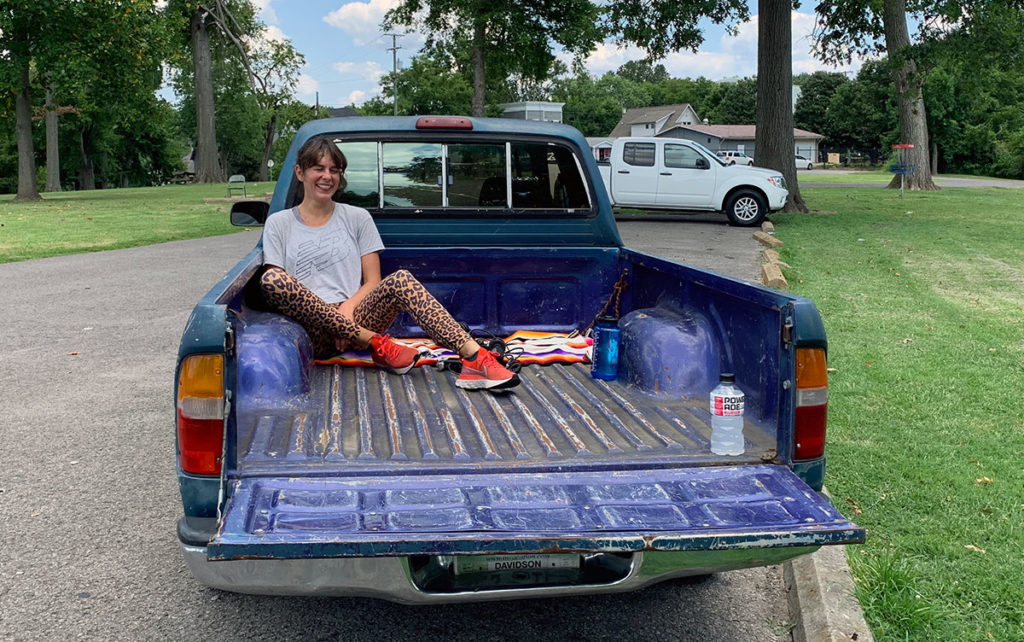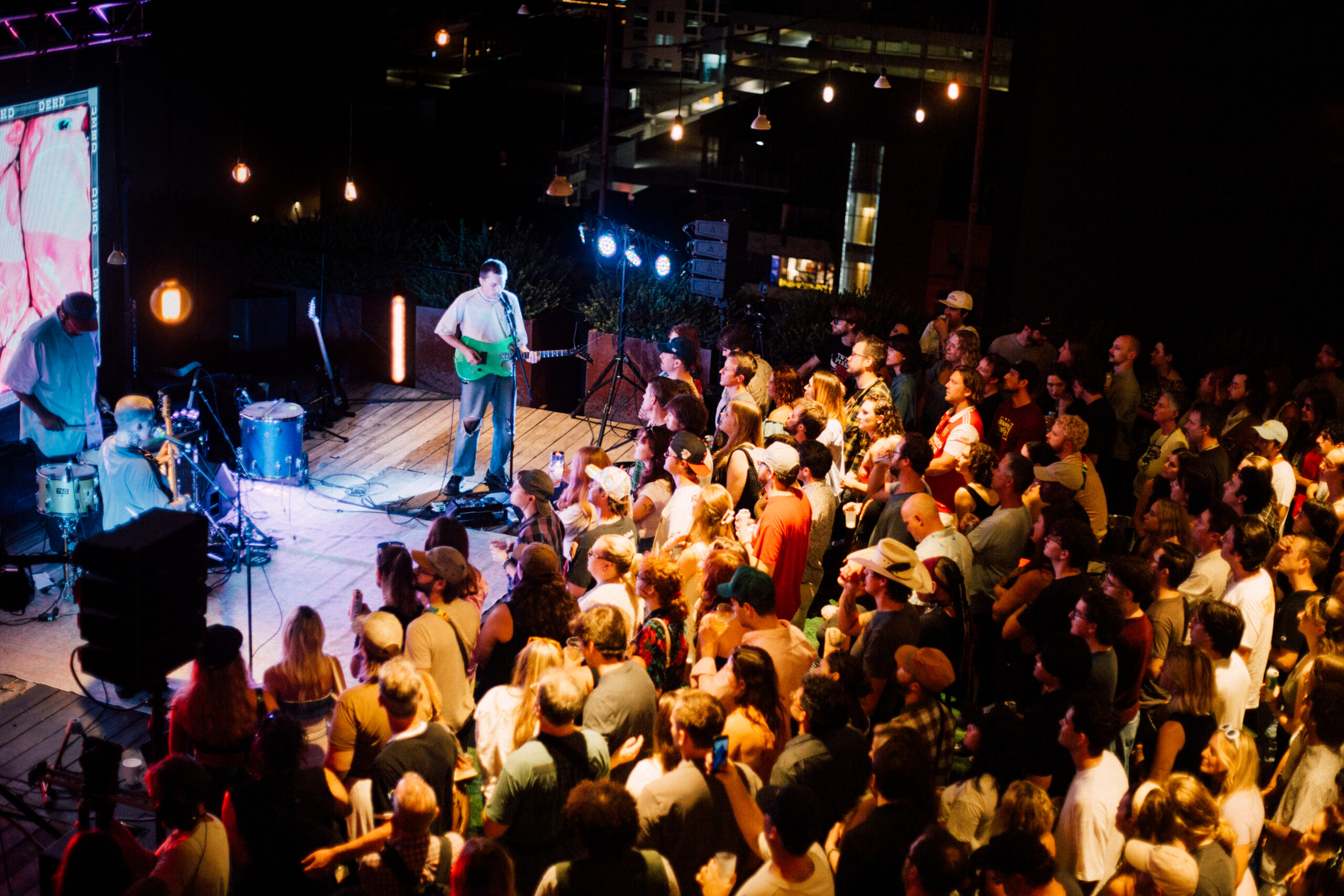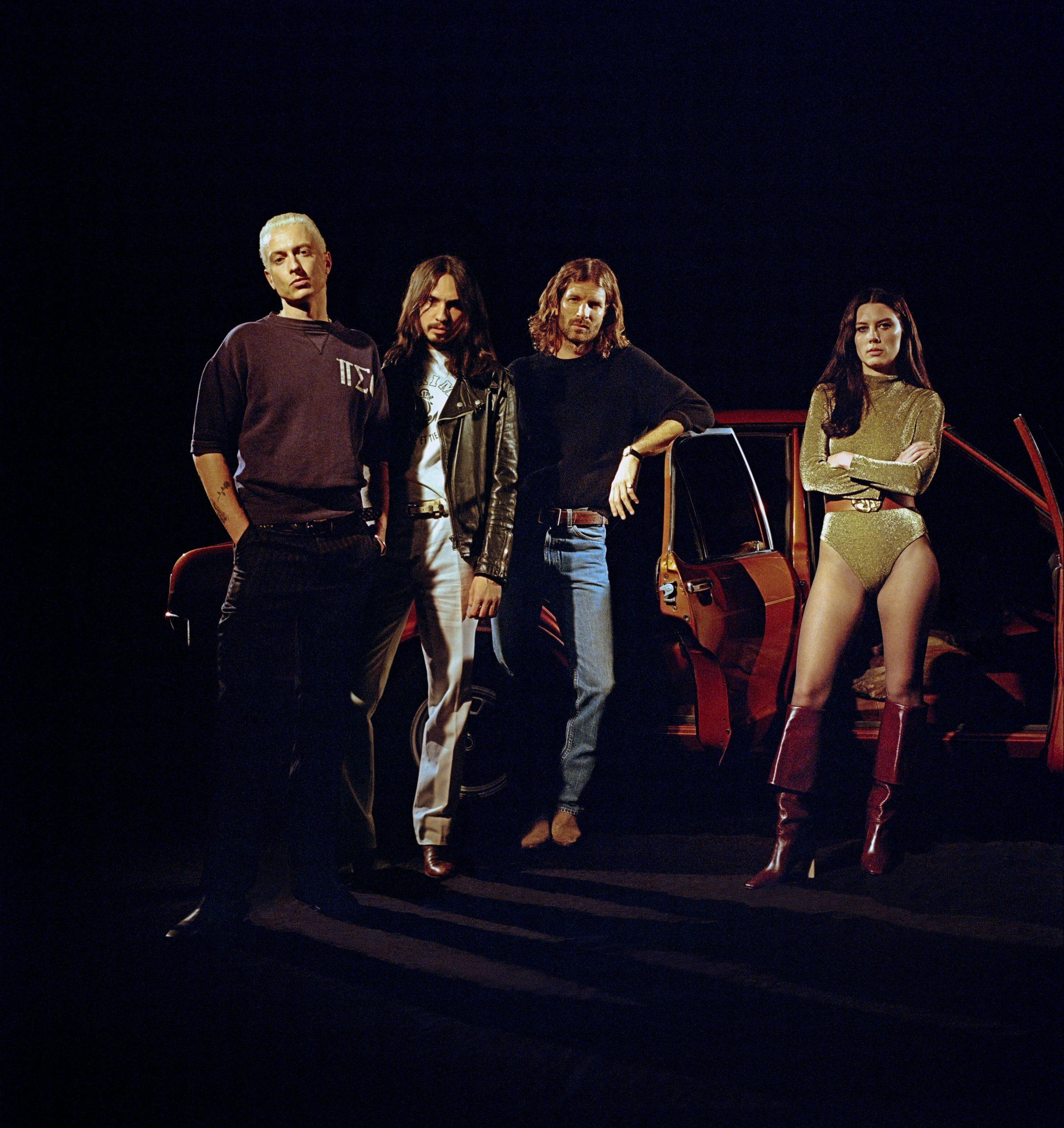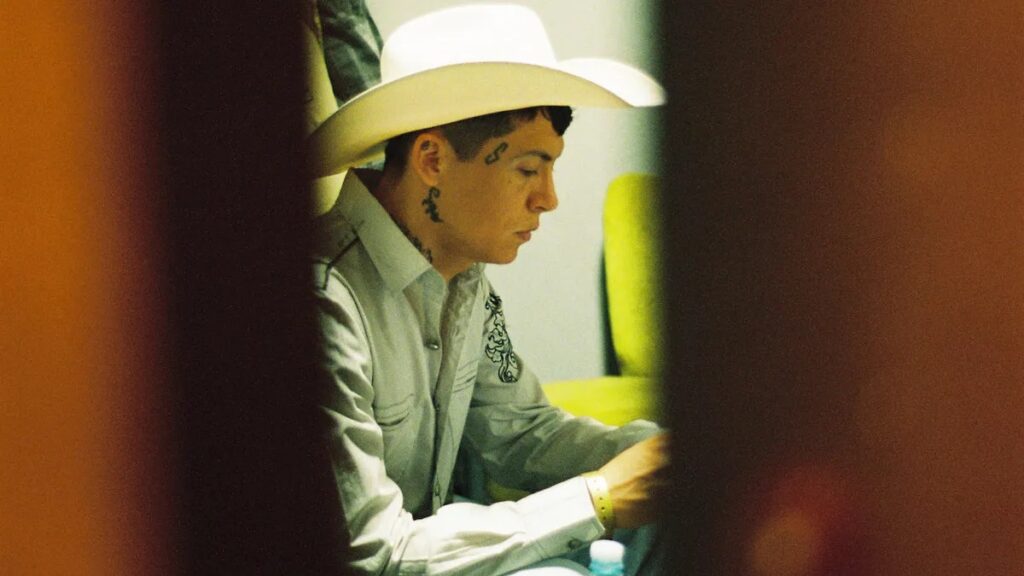Madi Diaz didn’t always grasp how to capture the unraveling of complicated emotions in her writing and delivery, but she certainly does now, as she displays during the chorus of “New Person, Old Place” from her new album History of a Feeling.
“What use to hurt doesn’t hurt anymore,” she sings, trailing off with relief.
“What used to work doesn’t work anymore,” she goes on, bringing quiet resolve to the line’s lilting, final word.
Then she brushes platitudes out of the way of her plainspoken wisdom: “And that’s just true—it’s not even brave. Can’t be a new person in an old place.”
Cast in a central role in the music video for that song is Diaz’s own squatty, blue-green 1997 Toyota Tacoma, the idea being to depict, as she puts it, “driving through and with different parts of yourself—like, past, present, future parts of yourself.”
The pickup is momentarily parked in front of its owner’s brick rental in East Nashville, where Diaz sits in a faded, plastic Adirondack chair, recounting the earliest part of her education.
She was homeschooled in Pennsylvania Amish country by her Danish father and Peruvian mother, both instrumentalists, who wanted their kids to explore music for themselves. “If we wanted help or if we wanted some sort of instruction, we would ask,” says Diaz. “Otherwise it was kind of a follow-your-heart mentality.”
Eventually, she got interested in the more intense instruction that her friends received at a Philadelphia program called School of Rock. “I begged my mom and she was a little squinty and side-eye at the whole ordeal,” Diaz remembers. It was up to Diaz and her brother to arrange their own transportation to and from classes at the coed school that inspired, first a documentary featuring a teenaged Diaz, then a comedy starring Jack Black in the lead role.
Diaz earned a scholarship to continue her studies at Berklee College of Music, though she usually couldn’t wait to get out of class, strap a guitar to her back and bike to open mics. Those appearances helped her land real gigs around Boston.
“That led to me finding my first manager and getting a crazy publishing deal too young and making my first bad decisions in my music career,” she says, dissolving into laughter. “Hooray!”
Then came what she views as a decade and a half of figuring things out, a journey best retraced in her truck.
Rising from her chair, water bottle, fanny pack and keys in hand, she leads the way. Her first act as tour guide is to retrieve a pair of pliers from the floorboard and adjust her manual windows. “I don’t know where my passenger side window crank is, so this is how I’ve been doing it,” she explains over her shoulder. “If you want it to go down any further, you know what to do. Just grab this handy Dewalt.”
Diaz steers around her block, through a few intersections and into another neighborhood, rolling to a stop in front of a corner cottage, her first Nashville home in the late 2000s. Her roommate at the time was Kyle Ryan, a Berklee classmate-turned-songwriting partner with whom she moved down from New England: “There was no place in Boston for sure that had a writing community and a production community and [was] just this cool music town where everybody wanted to meet each other and be around each other and create with each other.” She reels off the names of fellow musicians who used to come over back then—Ian Fituchuk, Daniel Tashian, John and T.J. Osborne, Keegan DeWitt, Charlie Worsham—all of whom now enjoy plum gigs.
Backyard hangs and scheduled songwriting appointments alike let Diaz see how friendship could free up creativity. “It really taught me the importance of being able to sit still or having a conversation with somebody where a song comes out of something real that you’re talking about,” she says.
This was a period when primetime hits like “Grey’s Anatomy” relied on singer-songwriter pop to soundtrack scenes of intimate melodrama. Diaz started landing songs in that and other shows, and just before she released what was expected to be her breakthrough album, Plastic Moon, her label folded. Her improvised response, she recounts a little gleefully, was “taking the label credit card and booking like, two months of hotels in an afternoon for tour, because it was just like, ‘I am not going down with this ship.’” She managed to get ownership of her masters, so that she could release the record on her own.
“When you’re a young artist, I think a lot of people expect it to just work out,” she muses. “And you expect promises to be true and you expect dreams to be real, because you’re already kind of halfway into the dream. When stuff didn’t work out, I was never going to stop pushing it through. It’s funny; now I expect everything to go wrong all the time.”
At the moment, she’s steering her pickup down a winding, tree-lined road in East Nashville that she finds appealingly serene. Back then, in search of other experiences, she signed a lease in L.A., took in the sounds of her new environment and tried a more danceable version of singer-songwriter pop: “808 [drum machine]s are fun, and who doesn’t like Robyn? I think I just really wanted to try to dance through the stuff that I was feeling, just to try that out. And I think it kind of worked for a minute for me. I don’t hate that version of my music.”
Phantom, the 2014 album to which Diaz applied that approach, in her summation, “did OK, but it didn’t blow the roofs off of anybody, and it didn’t really do the thing that everybody hopes that a record will do.” She means cement a distinct artistic identity in the minds of an audience.
“In the wake of that, I was wondering if I was just a really good partner,” Diaz reflects. Her focus shifted, for a time, toward a duo she formed with a longtime friend and another group she joined.
She’d also gotten very serious about her then-romantic partner. “I had never really allowed myself to go there on the level of ‘get married, have kids,’” she says, giving a sense of how significant this was. “I’d been so career-focused for so long, and I was in a totally new zone, realizing that those are kind of things that I want to be doing.”
But things had begun disintegrating: “We were going through stuff that couples do when you’re trying to really make those big life decisions. It kind of happened pretty naturally and ran its course, albeit in a very magnified and amplified sort of way.”
A fire displaced them from their home and, more pivotally, the partner that Diaz first knew as a man was transitioning into living as a trans woman.
After they split, Diaz couldn’t see herself staying on the West Coast, and loaded up the Toyota in 2017. “I absolutely hurled myself across the country,” she emphasizes. “I mean, I just kind of kept my head down and got back to Nashville as quick as possible so that I could physically and mentally unpack everything that happened.
The place that Diaz found to do that is the destination of today’s drive. It’s a hill in Shelby Park whose sweeping view encompasses the industrial operations across the Cumberland River. “I came here on so many lonely, full moon moments,” she says, playfully exaggerating the melancholy of those memories, “and just pulled my sad truck into this parking lot and backed my sad truck that up to the edge of the hill and set up my sad blanket.”
Curled up there in her truck bed, Diaz recorded her thoughts as voice memos, and later fleshed some of them out as songs. She no longer had a record deal or publishing contract, and sustained herself with a bartending gig, while pondering a new career in equine massage therapy. Her lifelong love of horses made her think she might not mind giving them back rubs.

For once, what Diaz did with music was entirely up to her. With no particular deadline on which she had to deliver any particular project, she estimates that she worked her way through as many as 200 songs, repeatedly chiseling on the same themes, until she had the 11 that make up this striking album. “I think it really just is time, and allowing there to be no plan and just continuing to express the thing that I’m feeling until I feel like I said it right. You know, I think I probably wrote 20 songs about resentment, but none of them were ‘Resentment,’” a captivating pensive portrait of festering feeling.
Diaz turned to the co-writers she knew and trusted, including Jarrad Kritzstein, who she’d met in L.A. nearly a decade earlier and reconnected with in Nashville.
He found her to be uncommonly open and unconcerned with pop songwriting convention: “I feel great with her being able to say, ‘That’s wrong. That’s not actually how you feel.’”
Nashville is a place where writing sessions often begin in casually conversational fashion, but this was beyond that. “She figured out how to pull off maybe the greatest magic trick ever, which is to make something that seems effortless, but, in fact, was very careful,” says Kritzstein, who received the occasional late-night text from Diaz, reconsidering a lyric they’d come up with together. “Someone who is both spontaneous and okay with messiness, but also a bit of a perfectionist, when those two things come together, I think this is what you get—you get something that doesn’t feel overthought, but feels thorough.”
A breakup always involves more than one person. Diaz was writing about an especially complex one—one that coincided with her ex coming to a profound realization about her gender identity—and Diaz understood that only certain parts of it were hers to tell. What she was after, and achieved to a degree that she never had before, was emotional clarity.
“There are no sides,” she says. “There is just this story. I’m not I’m not trying to be right; I’m just saying what I experienced.”
“When you love somebody and you respect somebody,” she goes on, “that’s just kind of mutual, and you can allow that experience to be separate from your own experience.”
Diaz’s wiry power-pop song “Nervous” itself contains multitudes, a tangle of longing and avoidance, self-delusion and acute self-awareness. During “Man In Me,” she sounds shaken by the fact that the intimate sense she had of a person has proved incomplete, even untrustworthy.
Diaz hadn’t recorded an album in a while, and she took a new approach with producer Andrew Sarlo, favoring the immediacy of her first takes. The thorniness of what she’s expressing is right at the surface of her singing, and the music sounds and feels so different, so much more wiry, bare-skinned and vital, than what she’s done for the last decade and a half. “I’ve tried so many ways of sounding,” she reflects. “I’ve tried the projectors and the lights and the backing tracks and I’ve tried so many things. And with this record, I was just kind of like, ‘What does it sound like if it’s just going to sound like me?’”
After the passage of years that Diaz considers to have been “so disastrously important,” she’s put her finger on precisely what just sounding like her means.




